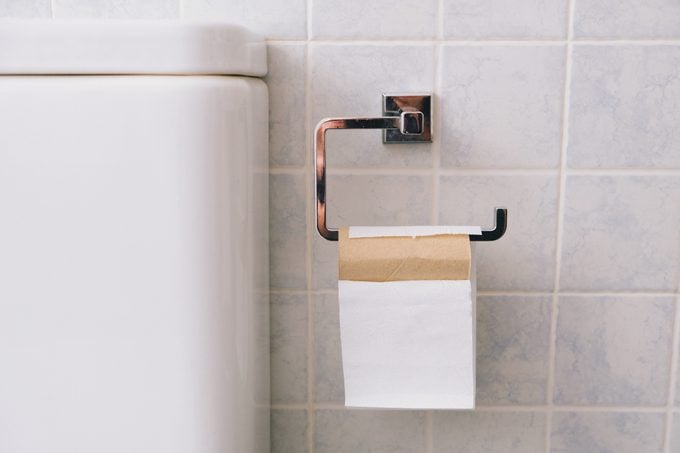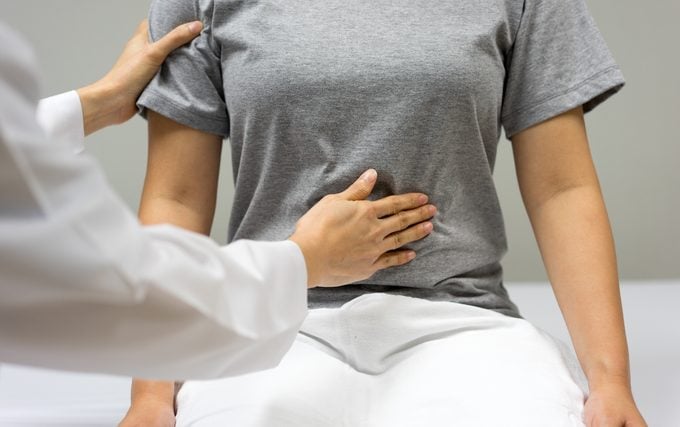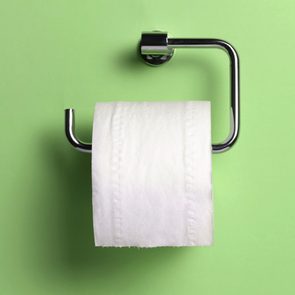Oily Stool: What Doctors Need You to Know About Steatorrhea
Updated: Mar. 17, 2022
No one really wants to talk about it, but oily poop—called steatorrhea—can be a simple case of what you ate, or something far more serious.
Last night, you treated yourself to a wonderfully rich dinner of duck confit followed by pecan pie topped with freshly whipped cream. Today, your post-coffee trip to the toilet turned out to be unusually unpleasant. (These are the toilet mistakes you didn’t know you were making.) Not to be indelicate, but how on Earth did that thing come out of you? Not only did it take three whole flushes to go down, but it also left…how was this even possible…a greasy stain in the bowl? This is actually known as steatorrhea, or the more commonly used term “oily stool.” (Here are the 9 weird pooping habits, explained by science.)

Oily stool, a.k.a. steatorrhea
Steatorrhea refers to bulky, foul-smelling, oily stool that tends to be pale in color and float in the toilet bowl, resisting flushing. (These are the 9 most common reasons your poop is black.) If it happens just once, or after a particularly fatty meal, especially if accompanied by a moderate amount (or more) of alcohol, then you have your reason: Consuming a lot of fatty foods can overwhelm your gastrointestinal (GI) tract and your body fails to digest it all, according to Baltimore colon and rectal surgeon, Jeffery Nelson, MD, the surgical director at The Center for Inflammatory Bowel and Colorectal Diseases at Mercy Hospital. As a result, some of that fat traveled straight through your gut and out the “exit” without getting digested. (Here are the signs your gut bacteria are unhealthy.)
But what if this isn’t the first time? “Any increase in the fat content of stool will produce pale, voluminous, malodorous, greasy stools,” according to Chicago-based family medicine physician, Kavita Shanker-Patel, MD. But when it’s a chronic problem that isn’t tied to consuming high amounts of fat and alcohol, that indicates you’re dealing with fat malabsorption. This describes the small intestine’s inability to properly draw some portion of the nutrients from the food you consume, whether fat, carbohydrates, protein, vitamins, or minerals. Fat malabsorption is one of the most prevalent forms seen by doctors. (Do you also have a green stool? Here’s why your poop is green.)
The question is, what is the cause of the fat malabsorption? Here are the possibilities, according to our medical experts:
You’re taking a weight loss pill
Weight loss medications that are known as “lipase inhibitors” can cause steatorrhea, says Dr. Shanker-Patel. Examples of these medications include Xenical and Alli (the generic name of these drugs is orlistat). The way they work is by blocking your body’s absorption of fat from foods. That makes them a powerful aid in weight loss (along with these other four weight-loss medications). But it also typically leads to greasy, loose stools, and sometimes diarrhea. (Here are 12 other reasons why you might be having for diarrhea.)
If you’re not taking a weight loss pill to intentionally disrupt your fat absorption, chronic steatorrhea is more likely caused by one of the following issues:
You have a malfunctioning pancreas
As Dr. Shanker-Patel explains, the pancreas makes digestive enzymes necessary for the absorption of nutrients like fat, protein, and carbohydrates. “If your pancreas isn’t working properly, you won’t be able to absorb fat from your gut into your bloodstream. Instead, it just runs right through to your stool.” When this happens, it is known clinically as exocrine pancreatic insufficiency (EPI). EPI is most frequently caused by one of the following conditions:
Chronic pancreatitis
Chronic pancreatitis refers to a continuing, long-term inflammation of the pancreas that causes malfunction in this vital organ. The most common causes of chronic pancreatitis, according to Dr. Nelson, are:
- gallstones (more on this later)
- pancreatic tumors (whether benign or pancreatic cancer)
- chronic excessive alcohol usage (as with cirrhosis, discussed below, this can cause debilitating scarring of the pancreas)
The symptoms most commonly associated with chronic pancreatitis, regardless of the cause, can include weight loss, diarrhea, and cramping. Accordingly, most people who have chronic pancreatitis are already well aware of their condition thanks to their symptoms, as well as a history of attacks that have likely required hospitalization, observes Dr. Shanker-Patel. In other words, oily stool, alone, is not likely to be a sign of chronic pancreatitis, in the absence of other symptoms. (Want to protect your gut? Here are the best foods to cleanse your colon.)
Cystic fibrosis
Cystic fibrosis (CF), a multisystem disease that involves thick, viscous internal bodily secretions, is another cause of EPI, Dr. Shanker-Patel explains. However, CF typically presents early in life, including at birth, with a difficulty in passing the first bowel movement (known as “meconium”). Babies with CF often have respiratory issues, have sweat that is unusually salty-tasting, and they can fail to thrive, in addition to passing bulky, particularly foul-smelling oily stool. Note that this is diagnosed in infancy or childhood, so having this in an adult would not likely be CF.

Your liver is dysfunctional
The liver produces bile, which assists in nutrient absorption, including fat absorption. Failure to produce bile, or enough bile can be caused by:
- Liver damage: High doses or regular, long-term use of acetaminophen can cause liver damage, especially if combined with alcohol. Other things can also cause liver damage including certain medications and drugs.
- Cirrhosis: Cirrhosis, which causes scar tissue to replace normal tissue in the liver, is most often caused by chronic, excessive alcohol use.
- Fatty liver disease: Fatty liver disease (FLD)—inflammation of the liver— can be a result of alcohol abuse, but it’s more often caused by obesity. (Here are 9 risk factors for non-alcohol-related fatty liver disease.)
- Liver infections: These include the various forms of hepatitis, including autoimmune hepatitis.
- Liver cancer: Rare, but serious, malignant tumors can cause liver cancer. This can also be due to some of the other liver conditions previously mentioned.
- Genetic liver disease: Alagille syndrome is a genetic disorder, present by the age of two, that affects the liver, the heart, and other parts.
The symptoms of any of these liver problems may include, according to our medical experts:
- nausea and vomiting
- swelling of the belly
- dark urine
- swelling in the ankles or legs
- persistent itching
- pain in the abdomen and back
- weight loss
- jaundice (a yellowing of the skin and or the white parts of the eyes, which is the result of elevated bilirubin levels in the body, which is consistent with biliary malfunction).
You have gallbladder problems
The gallbladder stores bile the liver has made, and the bile ducts leading out of the gallbladder are responsible for releasing bile into the GI tract to support digestion. Gallbladder dysfunction may be caused by:
- Gallbladder stones (aka gallstones): A gallstone is a small pebble-like mixture of bile, cholesterol, and calcium. These stones can block bile ducts or interfere with gallbladder function. Nausea, vomiting, and upper abdominal pain on the right side are among the most common symptoms, according to family practice physician, Christine Traxler, MD, a family practitioner at Invigor Medical, in Le Sueur, Minnesota.
- Gallbladder infection or inflammation of the gallbladder (cholangitis): According to Dr. Shanker-Patel, this is a bacterial infection in the biliary system tied to gallstones or obstruction in the bile duct. Gallstones and pain extending from the right shoulder and the right side of the upper back are just some symptoms.
- Gallbladder cancer: This type of cancer is not common, but it has the ability to alter the color of your stool. Note: Keep in mind that gallbladder cancer doesn’t always start with gallstones.
Note that when liver, bile, or gallbladder disrupted stools can also become “acholic” or pale, white and clay-like.
You have issues with your small intestine
Problems with the small intestine can interfere with nutrient absorption. A common and easily treatableone is celiac disease. This is an autoimmune condition in which the small intestine reacts to the introduction of gluten as if it were an attack. The resulting inflammation of the small intestine interferes with nutrient absorption, including fat absorption. If you’re experiencing oily stools and other symptoms of malabsorption, it’s best to consult with your physician, especially if you’re inclined to assume you’re suffering from celiac disease, which is often mistaken for one of these other digestive conditions.
Other diseases of the small intestine that can lead to malabsorption include the rare digestive disease tropical sprue, which impairs the small intestine’s function to absorb nutrients, and giardiasis—a diarrheal disease caused by the parasite Giardia. According to some experts, including San Antonio gastroenterologist, Lawrence Hoberman, an imbalance in small intestinal bacteria can also interfere with absorption, although the medical community has not yet come to a consensus on how precisely to define such an imbalance. (Nevertheless, gut health is critical, and here are 21 health secrets your gut might be trying to tell you.)






















